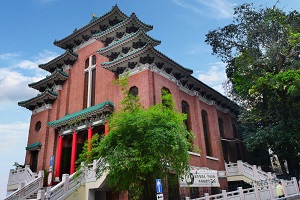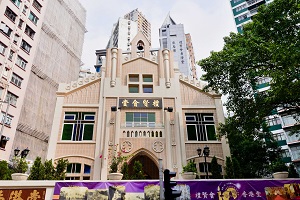Historic buildings of churches and temples
|
The fourth edition of Heritage Fiesta will be held from October 1 to November 30 this year, with churches and temples being this year’s theme to enhance our knowledge and understanding of historic religious buildings in Hong Kong. Each of the 22 churches and temples chosen has its own unique features. Apart from serving their congregations, some of the churches doubled as shelters for those who were suffering during the Japanese occupation, while some of the temples were used by the local community as places for resolving disputes. These 22 churches and temples are mostly open to followers. During Heritage Fiesta 2014, they will be open to all members of the public during specific hours for free visits. Some of the churches and temples will provide free guided tours to enhance public understanding of these historic buildings. Those interested may visit https://www.heritage.gov.hk for details. Additionally, you may also download the pamphlet for use in collecting the special stamps of the historic buildings as souvenirs when you visit the churches and temples. The 22 religious historic buildings are (in alphabetical order): Churches Temples I will now briefly introduce some of the churches and temples to let you know more about their histories and architectural features. (1) Hong Kong Sheng Kung Hui St John’s Cathedral, the mother church and cathedral of the Diocese of Hong Kong Island, Hong Kong Sheng Kung Hui, was declared a monument in 1996. The cathedral, in Early English and Decorated Gothic style, officially opened for worship in 1849. The bell tower and the church extension including the chancel and choir stalls were completed in 1850 and 1873 respectively. The cathedral also has three groups of stained glass windows which were installed after the Second World War. In addition, openable trefoil windows have also been installed to suit the subtropical climate in Hong Kong. (3) St Teresa’s Church, a Grade 1 historic building in Romanesque Revival architectural style, officially opened in 1932. During the Japanese occupation, the church itself remained unscathed but its services were interrupted. The bell tower and other rooms were used to store belongings of those who took refuge in the Mainland and Macau, and the church’s bronze bell, all gold altar ornaments and even the golden cross worn by the bishop were sold to help the needy. The iconic bell tower of the church, which was still ringing until the 1960s, is no longer in use. (4) Chinese Rhenish Church Hong Kong, a proposed Grade 3 historic building in Modern Eclectic architectural style, was built in 1914. During the Japanese occupation, the church was allowed to conduct Sunday worship due to its connection to Germany. The church houses an old bronze bell, which was cast in 1903 and donated in 1914 by the first Chinese follower and missionary of the Rhenish Church, Wong Yuen-sun, and a stained glass arched front door which has been in use since the establishment of the church. (5) Man Mo Temple Compound in Sheung Wan was declared a monument in 2010. As we all know, in the past many students would visit the temple and make their offerings in return for good examination results. The compound comprises three blocks, namely Man Mo Temple, Lit Shing Kung and Kung Sor, which were built sometime between 1847 and 1862. Man Mo Temple was built mainly for the worship of Man Cheong (the God of Literature) and Mo Tai (the God of Martial Arts). Lit Shing Kung was built for the worship of all heavenly gods, while Kung Sor was used by the Chinese community in the area as a place for meetings and for resolving disputes. The doorframe of Man Mo Temple and the granite doorframe of Kung Sor both were inscribed with the years of their construction, which were the 30th year of the reign of Daoguang in the Qing dynasty (1850) and the first year of the reign of Tongzhi in the Qing dynasty (1862) respectively. The main ridge of the front hall of the temple is decorated with Shiwan ceramic figurines, made in the 19th year of the reign of Guangxu in the Qing dynasty (1893), displaying the stage setting of Cantonese opera. (6) Tin Hau Temple in Causeway Bay was declared a monument in 1982. It was built by the Tai family probably in the early 18th century but the exact construction year is uncertain. Legend has it that the Tai family found, on the shore of Causeway Bay, a piece of red stone shaped like an incense burner. They believed that the stone was delivered from the goddess Tin Hau and thus built a temporary shrine for it. The shrine became so popular with fishermen that the Tai family raised funds to build a Tin Hau Temple on the same site. The temple is a two-hall structure. A cover was later added to the open courtyard between the two halls. The oldest relic preserved inside the temple is a historic bell cast in the 12th year of the reign of Qianlong in the Qing dynasty (1747). (7) I Shing Temple in Wang Chau, Yuen Long, was declared a monument in 1996. It was probably built in the 57th year of the Kangxi reign of the Qing dynasty (1718) by the residents of the six villages in Wang Chau, Ping Shan. The temple is not only a place for the worship of the two deities Hung Shing and Che Kung, but also has been a meeting place for the villagers of Wang Chau to discuss important matters. I Shing Temple is a two-hall green brick structure with an open courtyard in between, and there is a side chamber on each side of the open courtyard. The main ridge of the front hall is decorated with plaster mouldings with the auspicious motif of “carps jumping over the dragon gate”. (8) Kwun Yam Temple in Hung Hom, a very popular place during the Kwun Yam Open Treasury, is a Grade 1 historic building. It was built by the residents of Hung Hom Sam Yeuk So (namely Hung Hom Yuek, Hok Yuen Kok Yeuk and To Kwa Wan Yuek) in the 12th year of the reign of Tongzhi in the Qing dynasty (1873). The temple building was spared from bombing during World War II, though its surroundings were levelled. The residents in the area, therefore, believed that it was a miracle of Kwun Yam. The Kwun Yam Temple is a two-hall and one-courtyard structure fronted by two granite drum platforms at its main entrance. The main ridge of the front hall is decorated with plaster mouldings and Shiwan ceramic figurines, while the wall of the main entrance has mural paintings. All of these 22 churches and temples, with their unique histories and architectural features, are among Hong Kong’s precious cultural resources. We hope that Heritage Fiesta 2014 will enable you to appreciate these buildings up close and learn more about their different architectural styles. In addition, you are welcome to visit the exhibitions displaying photos of featured historic buildings being held at Pacific Place in Admiralty and the Hong Kong Heritage Discovery Centre in Tsim Sha Tsui from October 7 to 12 and from October 14 to 29 respectively.
|
|
28 September, 2014
Back
